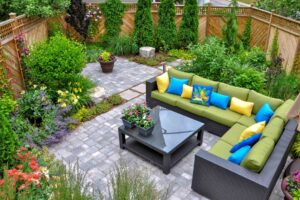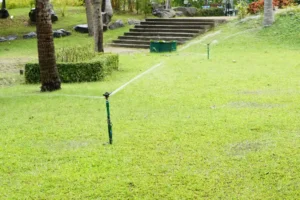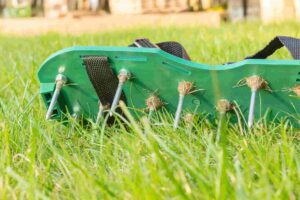Have you ever stepped into a garden that simply feels right? Every tree, path, and flowerbed fits together perfectly. It’s not a coincidence; it’s the consequence of careful planning and a deep understanding of what are the basic elements of landscape design? If you want to turn a normal space into an amazing landscape, you need to know these basics. This is true whether you’re a homeowner planning your dream backyard or a young designer interested in outdoor aesthetics.
It’s not enough to merely put flowers and bushes in your yard; you also need to make sure it looks well, works well, and is balanced. Before you put on your gardening gloves or look up what equipment landscape designers use, let’s take a look at the ten most important parts that make up any well-designed outdoor space.
10 Elements & Principles of Landscape Design
Every great garden design revolves around certain universal elements. These include line, form, mass, color, texture, balance, rhythm, focal points, function, and transition. Each one works together to create harmony and visual interest. Let’s break down how these landscape elements can bring your yard to life.
1. Line
Lines assist the eye move through a landscape by defining spaces and making things flow. You can think of them as the hidden routes that connect all the parts of your yard. They can be straight, which is great for a modern, formal garden, or curved, which makes the garden feel more natural and comfortable.
A curving stone path that goes through a rich garden, for example, offers movement and interest. Straight lines, like those made by manicured hedges or rectangular patios, on the other hand, suggest structure and order. The most important thing is to choose what mood or style you want your lines to have, such as a tranquil retreat or modern trendy.
Tip: Before you start planning your garden, draw out your paths and borders first. This provides you a clear plan before you begin to plant or build hardscapes.
2. Form & Shape
The form and shape of your landscape, including the outlines of trees, flowerbeds, and other garden features, make up its physical structure. Different shapes can change the way your yard feels a lot. Vertical trees provide height and drama, while rounded shrubs make things softer.
When you use natural materials to landscape, consider how the shapes of the plants work together. For example, tall grasses next to low-growing groundcovers make layers and depth. The way that shapes repeat themselves throughout your landscape makes everything work together.
A professional tip: before choosing plants or features, picture the garden in shadows. The forms themselves are just as significant as the colors and textures that fill them.
3. Mass / Weight
Mass, which is often termed weight, is the magnitude of things in a landscape that you can see. It’s about how much “space” something seems to take up, like a tree canopy, a boulder, or a sculpture in a garden. Mass gives your design shape and keeps it in place.
A big shade tree, for example, makes your yard feel more stable, and a group of tall perennials makes it look fuller. If you have an open lawn, utilize garden beds to fill in the “empty” spots. Your yard can feel empty if there is too much open space, and it can feel congested if there are too many dense features.
The key is to find balance, so that each area doesn’t feel too heavy or too light.
4. Color
Color is what gives your landscape life and emotion. It may shift the ambiance, draw attention to important areas, and make a room look bigger or smaller. Red, orange, and yellow are warm colors that grab the eye and make rooms feel more comfortable. Blues and purples are cool colors that make you feel peaceful and make small areas look bigger.
When choosing plants, think about more than just the colors of the flowers. The greens, silvers, and burgundies of the leaves are also quite essential. You can also utilize hardscape elements like stone, wood, or gravel to add neutral colors that balance out colorful flower gardens.
One wonderful piece of advice for landscaping is to think about color all year round. Put evergreen plants along with plants that bloom at different times of the year to keep your garden from seeming dreary.
5. Texture
Texture adds tactile and visual richness to your landscape. It’s the difference between soft, feathery ferns and glossy, bold-leaved tropical plants. The right combination of textures keeps your garden interesting from every angle.
Incorporating diverse materials like gravel, bark, or stone pathways enhances the sensory experience. For instance, rough bark next to smooth paving stones creates contrast and dimension. Even small gardens benefit from mixing textures; it helps prevent monotony and adds personality.
6. Balance, Proportion, and Scale
A well-designed landscape feels balanced, even if it’s asymmetrical. Balance refers to how visual weight is distributed throughout the design. Symmetrical balance uses mirrored plantings or structures on either side of a central feature. Asymmetrical balance, on the other hand, achieves harmony through contrast, perhaps a large tree on one side balanced by several smaller shrubs on the other.
Proportion and scale ensure that every feature fits comfortably within the space. A massive fountain might overwhelm a small yard, while tiny garden lights might look lost in a wide-open lawn. The goal is to make each element feel purposeful and in harmony with its surroundings.
These ideas tie closely to the principles of landscape design, emphasizing harmony, unity, and proportion.
7. Rhythm and Echoes
Just like music, landscapes have rhythm. It’s the repetition and spacing of elements that guide the viewer’s eye through the garden. Rhythm is created through recurring patterns like evenly spaced trees, repeating colors, or a consistent edging material.
“Echoes” occur when certain shapes or materials reappear throughout your design. For example, if you use circular stepping stones, repeating that shape in your garden beds or decor creates a cohesive theme.
By controlling rhythm and echoes, you keep the design visually engaging without becoming chaotic. This is one of the most underrated yet powerful parts of a landscape plan.
8. Focal Point
Every great landscape has at least one focal point , a visual anchor that draws attention. It could be a striking tree, a water feature, a sculpture, or even a seating area with a view. Focal points help organize your design and give it purpose.
When creating a focal point, consider scale and visibility. You want it to stand out but not overwhelm the rest of the garden. For instance, in a small yard, a simple birdbath or ornamental tree might be enough; in a large estate, a pergola or pond could take center stage.
A good focal point also changes with perspective offering something interesting to look at from every angle.
9. Function
Function is about more than looks, it’s how your landscape works. A beautifully designed garden that’s impossible to walk through or maintain isn’t successful. When planning, think about how each part of your yard will be used: relaxing, entertaining, gardening, or playing.
Consider sunlight, shade, water access, and traffic flow. For example, place seating areas where you’ll catch a gentle breeze, not direct sun. Install irrigation lines early to avoid digging through your finished beds. Practical thinking during the design phase saves time and frustration later.
This is where knowing what tools do landscape designers use can make a difference measuring tapes, design software, and layout stakes help visualize and test ideas before planting.
10. Transition
Transition brings everything together and makes it look like things are moving smoothly between sections. Changes in height, color, or texture that happen all of a sudden might be unsettling. Instead, try to make changes over time, like starting with tall shrubs, then moving on to mid-sized perennials, and finally groundcovers.
Transitions are quite critical in small yards when there isn’t much room. A careful mix of different plant sizes can make your garden look bigger and more put together. Transition is like a bridge that links all the other sections of a landscape. It helps your outdoor space feel like one big, natural environment.
Conclusion
Mastering what are the basic elements of landscape design isn’t about memorizing rules it’s about understanding how each element contributes to beauty, balance, and purpose. When these principles work together, they transform even the simplest yard into a peaceful retreat.
At Robert Complete Care, we believe that every outdoor space has the potential to become a living masterpiece. Whether you’re planning a backyard makeover or designing a new garden from scratch, our expert team offers professional Landscape Design Services in Whittier to bring your vision to life. From the first sketch to the final bloom, we combine creativity, craftsmanship, and sustainability to deliver landscapes that truly inspire.
Remember, a well-designed landscape is more than decoration it’s an experience. Take time to experiment, trust your instincts, and let nature be your guide.
FAQs
What is the first step in landscape design?
Start by observing your space sunlight, soil, drainage, and how you plan to use the area. Then sketch a rough design incorporating the main landscape elements like line, form, and texture.
How do I balance color in my garden?
Use the 60-30-10 rule: 60% dominant color (like greenery), 30% secondary hues, and 10% accent colors for highlights.
What tools do landscape designers use?
They rely on tools like CAD software, measuring tapes, shovels, pruning shears, and soil testers to plan and execute precise designs.
How can I make my small yard look bigger?
Focus on vertical space, use lighter colors, and create smooth transition between zones to draw the eye outward.
What’s the difference between elements and principles of landscape design?
Elements are the building blocks (like color, texture, and line), while principles guide how you use those elements balance, unity, and rhythm.







